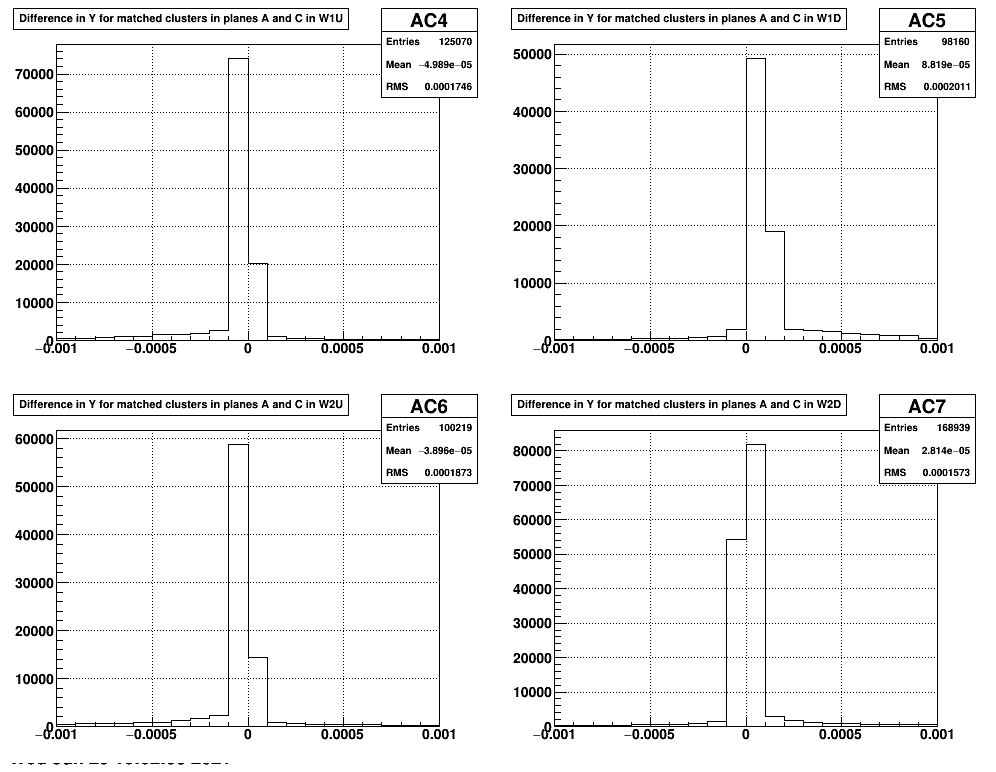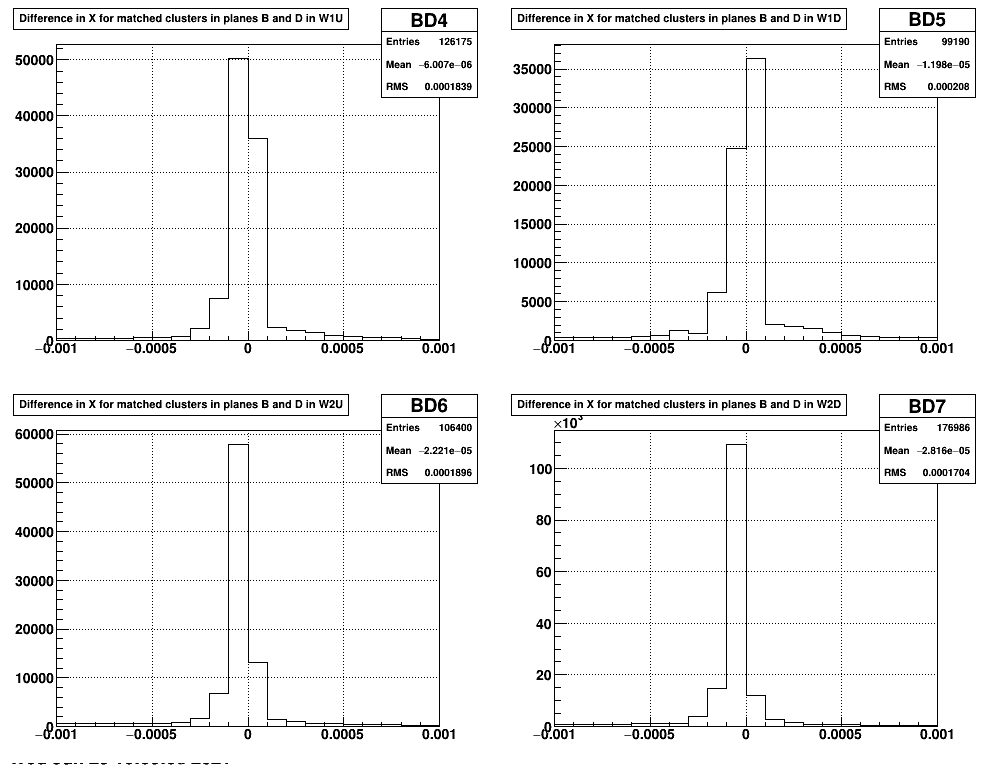recovered
-
Difference of positions of clusters (in m) when there are only 1 cluster in A/C planes or B/D planes (from Run 18174055) :
- Plane efficiencies (from Run 18174055) :
- Maximum lengths of clusters in the 4th plane when the other 3 planes have only 1 cluster (from 7 runs 18174055-18176018)
[ red histograms for the cases when the clusters in A/C or B/D are matched ;
black histograms for the cases without any matching requirement ] : - Energy (ADC) of matched clusters in the 4th plane when the other 3 planes have only 1 cluster for clusters with length ≤ 5 (from 7 runs 18174055-18176018) :
[ There was scintillator trigger cuts but NO silicon bunch cuts. ] - Number (ADC) of clusters in the 4th plane when the other 3 planes have only 1 cluster (from 7 runs 18174055-18176018) :
[ There was scintillator trigger cuts but NO silicon bunch cuts. ] - Efficiency of roman-pots in the x-y coordinates (from all RHICF 62 runs 18174055-18178017 except for W1D which was only for the first 14 runs, 18174055 - 18176035 before W1D-C plane stopped working) --- x/y coordinates in m
[ Efficiencies are measured for the 4th plane when there are trigger signals and the other 3 planes all have only 1 cluster in which two like-planes are matched within 0.5 mm. E.g., A, B/D all have 1 cluster and we look at plane C, and x = average of B&D (which are matched within 0.5 mm) and y = that of plane A; it's deemed to be efficient when there is one cluster in plane C matched with that of plane A ]:
- Efficiencies of roman-pot planes in the x-y coordinates (from all RHICF 62 runs 18174055-18178017 except for "W1D-C" which was only for the first 14 runs, 18174055 - 18176035 before W1D-C plane stopped working) --- x/y coordinates in m
[ Efficiencies are measured for the 4th plane when there are trigger signals and the other 3 planes all have only 1 cluster in which two like-planes are matched within 0.5 mm. E.g., A, B/D all have 1 cluster and we look at plane C, and x = average of B&D (which are matched within 0.5 mm) and y = that of plane A; it's deemed to be efficient when there is one cluster in plane C matched with that of plane A ]:
- The same efficiencies of roman-pot planes in the x-y coordinates as above, except this time we only consider clusters with length ≤ 5 with energies (ADC's) higher than thresholds for their given lengths:
[ The energy thresholds that I've used are (in the order of "E1U, E1D, E2U, E2D, W1U, W1D, W2U, W2D" and lengths of "1, 2, 3, 4&5" ) :
{ {20, 28, 50, 66}, {20, 28, 50, 60}, {20, 28, 50, 60}, {20, 28, 45, 60}, {20, 28, 50, 60}, {20, 26, 50, 60}, {20, 28, 50, 60}, {20, 28, 50, 60} } ; ]
































The above was done with the 0.5 mm matching criterion and I've stored the histograms in root files in xyeff_0.5mm_enlencuts.tar.gz .
- XY coordinates (in m) on the roman pots of the tracks on two opposite arms (EU-WD or ED-WU) :
[ Each track is formed by two roman-pots on each side. In each pot, if there are more than one pair of clusters in the A/C or B/D planes, I use the pair with the closest match in positions; if there is one cluster in A (B) but not C (D), or vice versa, I use that one existing cluster as the cluster position. Events in the circumstance that there are more than 1 cluster on one plane but none on the other are rejected.
The angle (θX or θY ) is formed by the two roman-pots in one arm is compared with that of the opposite arm, only when they agree within 3σ's, these two opposite tracks are accepted. Moreover, a fit is also performed in the form of XRP = XIP + θX • (ZRP - ZIP), and similarly for θY. The fit has the effect of assuring that both tracks come from the IP (Interaction Point). θX/θY's obtained by these two methods are also compared and the track pair/event is accepted only when they agree (within 0.000125 radians). This procedure would eliminate tracks which don't come from the IP and often have very small fitted θX/θY ≈ 0 (as the fit fails). ]

- Plots of -t (GeV/c)2 in UA4 bins from 0.19 to 1.11 with the same cuts/criteria as above :



We measure plane efficiency for plane D (for example), when there is one and only one cluster in A/C and B planes in which the clusters in A and C are matched within 0.5 mm. [ It's known that the planes E2U-A (index 8) and W2D-C (index 30) were missing a SVX and therefore they should get lower efficiencies as 1/4 of the planes couldn't register any signal. ]
If we count plane D as "efficient" whenever there is non-zero cluster on plane D, we obtain the following efficiencies on various planes:

Nevertheless, if count plane D as "efficient" only if one of the cluster on plane D matched with the only cluster on plane B (with the same above-mentioned criterion), we find the following efficiencies:

If we change the cluster matching criterion from 0.5 mm to 0.25 mm, one'd obtain the following result when we don't match cluster in B & D (in our example of narration):

If we require matching clusters in B and D to be < 0.25 mm (as well as between A/C), we see the following :

As requested by Wlodek Guryn,I did the above for two groups of runs which Wlodek called "hpos" (high luminosity) and "lpos" (low luminosity). And since all these would have problems for the W1D-C plane, I also did the same for 14 runs before W1D-C plane had problem. The result has been stored in the tar-gzipped file: xyeff_0.5mm.tar.gz.
The above were all done using the matching criterion of within 0.5 mm between the two clusters in two planes.
When I changed the criterion to be 0.25 mm, the result has been stored in this tar-gzipped file: xyeff_0.25mm.tar.gz .
- yipkin's blog
- Login or register to post comments




































































